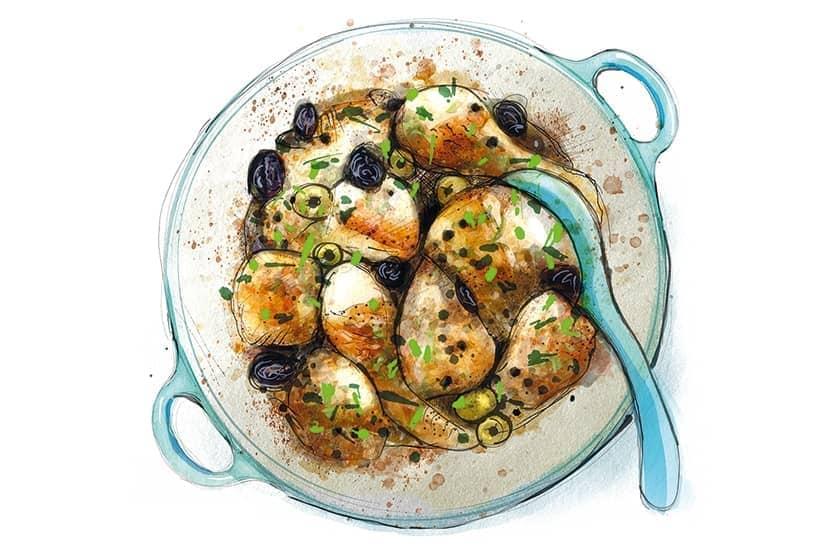What is it about retro food? I don’t mean nostalgic food, from school dinner favorites to your grandmother’s signature dishes. I mean food you’ve probably never even tried. Thoroughly old-fashioned dishes that nevertheless light up your culinary imagination — or at least mine. I’m talking deviled eggs. Prawn cocktail. Beef stroganoff.
Perhaps it’s because many of these recipes hail from the golden age of dinner parties. They speak of glamour, excess, a touch of kitsch, all washed down with a snowball. These are dishes that should be accompanied by shoulder pads and strong opinions about the royal wedding. Following a long period in which it was illegal to hold a dinner party, I crave retro food more than ever.
These dishes were popular for two reasons. One, they were easy to make. Two, they tasted good. My pick of the lot is chicken Marbella: an American dinner party dish much neglected elsewhere. Pieces of chicken are nestled alongside fat olives and briny capers, sweet, juicy prunes and wine, vinegar, lots of garlic, oregano, olive oil and sugar. The whole thing is roasted until the chicken skin is burnished and crisp, the prunes slightly caramelized, the olives squishy, and everything else has thickened just enough to form a spoonable sauce. The result is outrageously flavorsome: garlicky, winey, a balance of sweet, sour, and salty, all bathed in chicken juices.
Like all good dinner party dishes, chicken Marbella can be prepared in advance and bunged in the oven while you attend to the deviled eggs. It is, in essence, a tray bake. The chicken is marinated overnight before being tipped into a pan with white wine and a sprinkling of sugar, then baked for under an hour. It is also a good weeknight supper.
So, why Marbella? Good question. Chicken Marbella has little for which to thank the Costa del Sol, originating as it did on Manhattan’s Upper West Side. In the late 1970s, Sheila Lukins and Julee Rosso set up a gourmet food store, the Silver Palate, which sold high-end fully prepared meals. They initially offered three main dishes: baked tenderloin of beef, baked ham and chicken Marbella. Chicken Marbella was the runaway success, and so was the business as a whole.
The inevitable spin-off cookbook, published in 1982, was wildly successful and is said to have changed the way Americans cooked. Chicken Marbella quickly became a mainstay of dinner parties across the country. The dish was inspired, Lukins later explained, by the cuisine of southern Spain and the tagines of Morocco, but its relationship to Marbella is more of a romantic notion than anything else.
The Silver Palate store is no more but chicken Marbella has moved from being a hip New York dish to an all-American classic. Countless variations have emerged, with everyone from Ina Garten to Yotam Ottolenghi riffing on it — changing the dried fruit, adding nuts, removing the sugar, switching from white wine to red. But for me, the original combination is king. My only significant deviation is in quantity, which called for four whole chickens — excessive unless you’re feeding a football team. I’ve gone for one, which will still comfortably feed four.
If you’re nervous about jointing a chicken, you can make this recipe with six bone-in, skin-on chicken thighs. But I’d encourage you to give the jointing a go. For one thing, it’s cheaper. For another, it’s easier to get hold of high-quality whole chickens than chicken pieces. Plus, with a dish like this, it doesn’t matter if you make a hash of it.
You don’t need to seek out your power suit to enjoy chicken Marbella. You don’t even have to follow it up with a Viennetta, or serve it alongside a nice oaky Chardonnay (although that would go well). Chicken Marbella hasn’t stuck around for 40 years because of irony but because it’s delicious and has earned a place in America’s culinary hall of fame. With the return of dinner parties, it should become a British favorite, too.
How to make it
Serves: 4
Takes: 10 mins, plus jointing the chicken and overnight marinating
Bakes: 50 mins
– 1 large whole chicken (or jointed, or 6 bone-in, skin-on chicken thighs)
– 4 cloves of garlic, finely chopped
– 1 fl oz olive oil
– 1 fl oz red wine vinegar
– 1 tbsp dried oregano
– 3½ oz pitted prunes
– 1¾ oz capers
– 1¾ oz pitted green olives
– 1¼ oz light brown sugar
– 2 fl oz white wine
– 1 handful chopped parsley
First, joint your chicken. Pull the leg away from the body and, using a sharp knife, slice between the body of the chicken and the leg; pop the joint out, and cut around it to release the thigh and leg. Find the joint in the middle of the leg and slice through it to separate the thigh and drumstick. Slice along and down either side of the breastbone. Keep the knife close to the breastbone to retain as much meat as possible, and follow its curve until you release the breast. Slice each breast into two horizontally. You can use the carcass and chicken wings for stock.
In a large Tupperware or other type of bowl, combine the garlic, olive oil, red wine vinegar, dried oregano, prunes, capers and olives, and season generously. Turn each of the chicken pieces in the mixture, cover tightly with a lid or clingfilm, and leave to marinate overnight.
The following day, preheat the oven to 355°F. Lay the marinated chicken snugly in a single layer in a baking pan or dish. Spoon the marinade around the chicken pieces. Sprinkle with sugar and then pour the white wine around the pieces of chicken. Bake the whole thing, uncovered, for 50 minutes, basting once halfway through the cooking time. Sprinkle with chopped parsley and serve.
This article was originally published in The Spectator’s UK magazine. Subscribe to the World edition here.

























